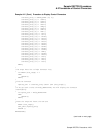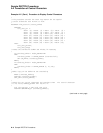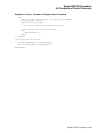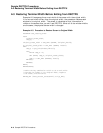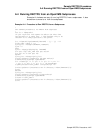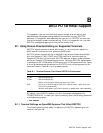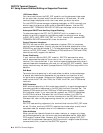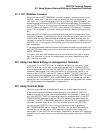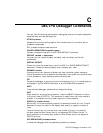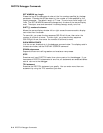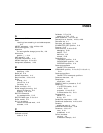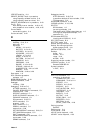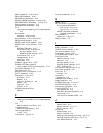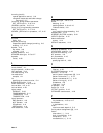DECTPU Terminal Support
B.1 Using Screen-Oriented Editing on Supported Terminals
B.1.2 SET TERMINAL Command
When you use the SET TERMINAL command to specify characteristics for your
terminal, make sure to set only those characteristics that are supported by
your terminal. If you set characteristics that the terminal does not support, the
screen-oriented functions of DECTPU may behave unpredictably. For example, if
you run DECTPU on a VT100 terminal and you set the DEC_CRT2 characteristic
that VT100s do not support, DECTPU tries to use 8-bit CSI controls. This could
cause ‘‘;7m’’ to appear on the screen where the reverse video attribute should be
set.
Most users do not knowingly set characteristics that are not supported by their
terminals. However, if you temporarily move to a different type of terminal, your
LOGIN.COM file may have characteristics set for your usual terminal that do
not apply to the current terminal. This problem may also occur if, before running
DECTPU, you run a program that modifies your terminal characteristics without
your knowledge.
If you see unexpected video attributes or extraneous characters on the screen, exit
from DECTPU and check your terminal characteristics with the DCL command
SHOW TERMINAL.
To recover your files, use the same terminal characteristics you used to create
your file; otherwise, a journal file inconsistency may occur, depending on how
your interface is written.
B.2 Using Line-Mode Editing on Unsupported Terminals
If you want to run DECTPU from an unsupported terminal, you must inform
DECTPU that you do not want to use screen capabilities. To invoke DECTPU
on an unsupported terminal, use the /NODISPLAY qualifier after the EDIT/TPU
command. See Chapter 2 for more information on this qualifier. While in no-
display mode, DECTPU uses the RTL generic LIB$PUT_OUTPUT routine to
display prompts and messages at the current location in SYS$OUTPUT. By using
a combination of the READ_LINE and MESSAGE built-in procedures, you can
devise your own line-mode editing functions or perform editing tasks from a batch
job. See the sample line-mode editor in Appendix A.
B.3 Using Terminal Wrap
Terminal wrap characteristics perform differently on each operating system.
If you have enabled an automatic wrap setting on your terminal, DECTPU
disables this setting in order to manage the screen more efficiently. When you
exit from DECTPU, DECTPU restores all terminal characteristics. If the SET
TERM/NOWRAP command is active, DECTPU leaves the hardware wrap off.
However, if the SET TERM/WRAP command is active, DECTPU assumes that
you want hardware wrap on, so it turns it on when you exit from DECTPU.
You can prevent DECTPU from turning on hardware wrap by specifying
SET TERM/NOWRAP before invoking DECTPU. You can enter the command
interactively, or you can write a DCL command procedure that makes this
setting part of your DECTPU environment. Example B–1 shows a DCL command
procedure that is used to control this terminal setting before and after a DECTPU
session.
DECTPU Terminal Support B–3



